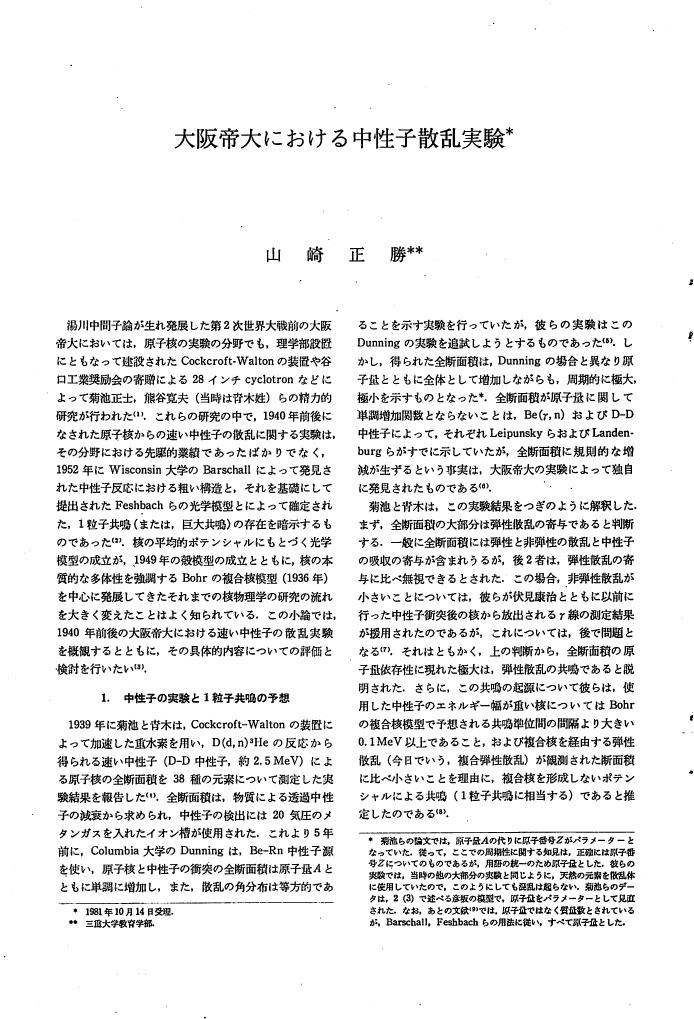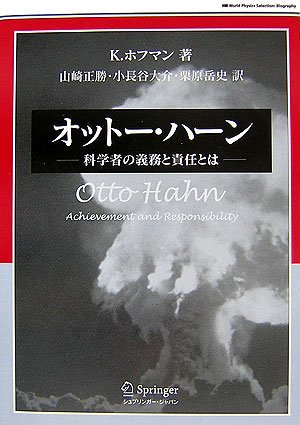1 0 0 0 OA シンポジウム:日本戦時科学史の現状と課題(2003年度年会報告)
1 0 0 0 OA マックス・プランク協会における戦時研究見直しプログラム(アゴラ)
1 0 0 0 OA 理研の「ウラニウム爆弾」構想 : 第二次世界大戦期の日本の核兵器研究
- 著者
- 山崎 正勝
- 出版者
- 日本科学史学会
- 雑誌
- 科学史研究 (ISSN:21887535)
- 巻号頁・発行日
- vol.40, no.218, pp.87-96, 2001 (Released:2021-08-17)
Soon after the dropping of the Hiroshima bomb, Yoshio Nishina, an experimental physicist who was in charge of the Army's development of nuclear weapons at Riken, the Institute of Physical and Chemical Research, could understand that it was an atomic bomb because its energy release given in Truman's statement coincided with the one that his colleague Hidehiko Tamaki estimated a few years ago. This suggests that they knew of the magnitude of nuclear explosions. Uraniumu bakudan (uranium bomb), Japanese physicists' bomb at the time, is, however, known to be a kind of nuclear reactor out of control. The "bomb" of this kind is not very powerful because it is based on a slow-neutron reaction. This paper challenges to reproduce Japanese physicists' calculations at the time, and shows that they thought that they could explode their uraniumu bakudan, a slow- reactor bomb, with a quite high efficiency. This led them to expect that the energy release from their bomb would be of 20 K ton TNT equivalence that accidentally coincided with the energy release of the Hiroshima bomb.
1 0 0 0 OA シンポジウム:「科学史・技術史の今日的課題」Ⅰ
1 0 0 0 OA ガリレオにおける振子の法則と落下の法則
- 著者
- 山崎 正勝
- 出版者
- 日本科学史学会
- 雑誌
- 科学史研究 (ISSN:21887535)
- 巻号頁・発行日
- vol.32, no.185, pp.12-18, 1993 (Released:2021-03-23)
1 0 0 0 OA 展望:原爆開発の科学技術史研究 -資料紹介を中心に-
1 0 0 0 OA 現代における戦争と科学技術 ―SDI問題を考える―(学会報告)
1 0 0 0 OA 第二次世界大戦期における原爆の物理学的研究と核兵器工学の成立
- 著者
- 山崎 正勝
- 出版者
- 日本科学史学会
- 雑誌
- 科学史研究 (ISSN:21887535)
- 巻号頁・発行日
- vol.25, no.160, pp.225-234, 1986 (Released:2021-09-22)
The first idea of atomic bomb proposed by E. Fermi and, especially, L. Szilard, who was the real writer of Einstein's letter to President F D Roosevelt in 1939, was shown to be based on a fast neutron chain reaction in normal uranium which was later proved to be inert for fast neutrons At that time such an idea was also proposed independently by L. Peierls in Britain, but he soon abandoned it because of its great critical mass estimated theoretically by himself. The large scale enrichment of uranium was at first pursuited to produce a thermal nuclear chain reaction (the nuclear reactor) effectively. This stream was thus independent of that for the construction of the bomb at the early stage Those two streams above were, however, joined together in 1940 by O. Frisch and Peierls in their memorandum on a super bomb, which first showed the technological principle of atomic bomb based on the fast neutron chain reaction in pure uranium 235 In contrast to these two streams in the U.S. were kept divisitive by compartmentalization of information adopted by V.Bush, the chairman of NDRC. The idea of the Frisch-Peierls memorandum is studied in detail in comparison with the MAUD reports, the British official reports, completed in the summer of 1941. It is shown that the influence of the British research on the atomic bomb was the most important factor for the full start of the development of the bomb in the U.S. in the autumn of 1941. The problem on independence between NAS report of November 6,1941 and the MAUD reports is discussed.
1 0 0 0 OA 大阪帝大における中性子散乱実験
- 著者
- 山崎 正勝
- 出版者
- 日本科学史学会
- 雑誌
- 科学史研究 (ISSN:21887535)
- 巻号頁・発行日
- vol.21, no.141, pp.10-15, 1982 (Released:2021-05-13)
1 0 0 0 オットー・ハーン : 科学者の義務と責任とは
- 著者
- K.ホフマン著 山崎正勝 小長谷大介 栗原岳史訳
- 出版者
- シュプリンガー・ジャパン
- 巻号頁・発行日
- 2006
- 著者
- 山崎 正勝
- 出版者
- 日本科学史学会
- 雑誌
- 科学史研究 (ISSN:21887535)
- 巻号頁・発行日
- vol.53, no.270, pp.199, 2014 (Released:2020-12-09)
Japan and the United States signed in 1968 a new atomic energy agreement through which US light-water nuclear reactors, including those of the Fukushima Daiichi Nuclear Power Plant of Tokyo Electric Power Company, were to be introduced into Japan. This paper studies the history of negotiations for the 1968 agreement using documents declassified in the 1990s in the US and Japan. After the success of the Chinese nuclear test in October 1964, the United States became seriously concerned about nuclear armament of other countries in Asia including Japan. Expecting that Japan would not have its own nuclear weapons, the US offered to help the country to demonstrate its superiority in some fields of science including peaceful nuclear energy to counter the psychological effect of the Chinese nuclear armament. Driven by his own political agenda, the newly appointed Prime Minister Eisaku Sato responded to the US expectation favorably. When he met in January 1965 with President Johnson, Sato made it clear that Japan would not pursue nuclear weapons. Although the US continued its support after this visit, it nevertheless gave priority to the control of nuclear technology in Japan through the bilateral peaceful nuclear agreement. This paper argues that the 1968 agreement implicitly meant a strategic measure to prevent Japan from going nuclear and also a tactic to persuade Japan to join the Nuclear Non -Proliferation Treaty.
- 著者
- 山崎 正勝
- 出版者
- 日本科学史学会
- 雑誌
- 科学史研究. 第II期 (ISSN:00227692)
- 巻号頁・発行日
- vol.48, no.249, pp.11-21, 2009-03-25
In the early years of the Cold War, both the United States and the Soviet Union used their nuclear power technology as a diplomatic tool for expanding their political influence on respective friendly nations. On December 8, 1953, the United States initiated a new international nuclear program with President Dwight D. Eisenhower's "Atoms for Peace Address" before the General Assembly of the United Nations. This program regarded Japan as one of the most promising countries that could introduce nuclear power plants since it consumed a huge amount of energy while being short of natural resources. This paper studies the historical process of the atomic energy agreement between Japan and the US in 1955 using declassified documents in both countries. It shows that in spite of various proposals of the introduction of nuclear power plants into Japan including that of Congressman Sydney Yates, the final agreement was only for research reactors because American authorities felt that such proposals might mean an admission of US guilt in atomic bombing. It also argues that the agreement was one of steps toward the hegemony of bureaucrats and politicians in Japanese nuclear policy that made the leadership of scientists, especially those of the Science Council of Japan, decline.
- 著者
- 山崎 正勝
- 出版者
- 日本科学史学会
- 雑誌
- 科学史研究. 第II期 (ISSN:00227692)
- 巻号頁・発行日
- vol.40, no.218, pp.87-96, 2001-06-28
- 被引用文献数
- 1
Soon after the dropping of the Hiroshima bomb, Yoshio Nishina, an experimental physicist who was in charge of the Army's development of nuclear weapons at Riken, the Institute of Physical and Chemical Research, could understand that it was an atomic bomb because its energy release given in Truman's statement coincided with the one that his colleague Hidehiko Tamaki estimated a few years ago. This suggests that they knew of the magnitude of nuclear explosions. Uraniumu bakudan (uranium bomb), Japanese physicists' bomb at the time, is, however, known to be a kind of nuclear reactor out of control. The "bomb" of this kind is not very powerful because it is based on a slow-neutron reaction. This paper challenges to reproduce Japanese physicists' calculations at the time, and shows that they thought that they could explode their uraniumu bakudan, a slow- reactor bomb, with a quite high efficiency. This led them to expect that the energy release from their bomb would be of 20 K ton TNT equivalence that accidentally coincided with the energy release of the Hiroshima bomb.
- 著者
- 山崎 正勝
- 出版者
- 東京工業大学大学院社会理工学研究科経営工学専攻技術構造分析講座
- 雑誌
- 技術文化論叢 (ISSN:13476262)
- 巻号頁・発行日
- no.15, pp.25-37, 2012








